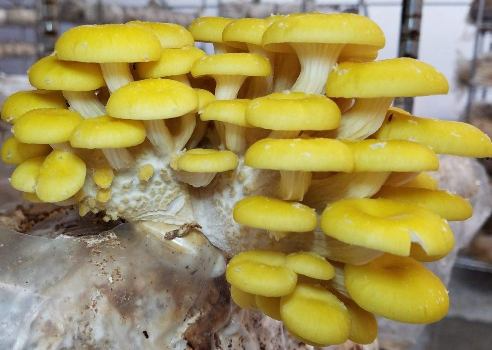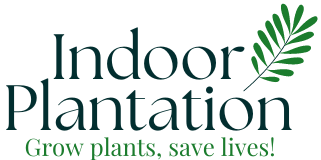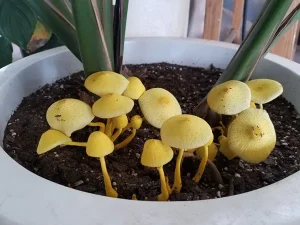Introduction to Yellow Mushrooms in Potted Plants
Yellow mushroom, also known as Leucocoprinus birnbaumii, are a common sight in potted plants. These fungi often appear unexpectedly, causing concern among plant enthusiasts. Understanding why these mushrooms grow in potted plants and how to manage them is crucial for maintaining healthy indoor gardens.
What Are Yellow Mushroom?
These are characterised by their bright yellow colour, umbrella-like cap, and gilled undersides. They are commonly found in potting soil, particularly in warm, humid environments. These mushrooms are part of the larger fungi kingdom, thriving in organic matter-rich soils.
Causes of Yellow Mushroom Growth in Potted Plants
- Moisture: Excessive watering creates a damp environment conducive to mushroom growth.
- Soil Conditions: Potting soil rich in organic material can harbour mushroom spores.
- Spore Contamination: Spores can be introduced through new plants, contaminated soil, or even through the air.
Identifying Yellow Mushrooms in Your Plants
- Visual Identification: Bright yellow colour, umbrella-shaped caps.
- Symptoms: Presence of mushrooms around the base of the plant, yellow spots on the soil.
- Differentiating from Other Fungi: Unlike mould, yellow mushrooms have a distinct cap and stem structure.
Is Yellow Mushroom Growth Harmful?
These are generally not harmful to plants but can be toxic to humans and pets if ingested. They can also indicate overwatering or poor soil conditions, which may affect plant health.
Preventing Yellow Mushroom Growth
- Soil Management: Use high-quality, well-draining potting soil.
- Proper Watering Techniques: Avoid overwatering and ensure the soil dries out between waterings.
How to Remove Yellow Mushrooms from Potted Plants
There are several methods to remove from potted plants:
- Manual Removal: Gently pull the mushrooms out, including the roots.
- Chemical Treatments: Use fungicides carefully, following manufacturer instructions.
- Natural Remedies: Baking soda or vinegar solutions can deter mushroom growth.
Best Soil Practices to Avoid Fungal Growth
Implementing best soil practices is key to preventing fungal growth.
- Soil Selection: Choose sterile, well-draining soil mixes.
- Sterilisation Methods: Sterilise soil by baking or using boiling water.
- Drainage Solutions: Ensure pots have adequate drainage holes to prevent waterlogging.
Role of Humidity in Mushroom Growth
Controlling humidity is crucial in preventing mushroom growth.
- Controlling Humidity: Use dehumidifiers or increase ventilation around plants.
- Indoor Plant Care Tips: Avoid placing plants in overly humid areas, such as bathrooms.
Impact of Organic Matter on Mushroom Growth
Organic matter can contribute to mushroom growth.
- Composting Practices: Ensure compost is well-matured before adding it to potting soil.
- Organic vs. Inorganic Soil: Consider using inorganic soil amendments to reduce organic matter content.
Using Fungicides: Pros and Cons
Fungicides can be effective but come with pros and cons:
- Types of Fungicides: Organic vs. chemical options.
- Application Methods: Sprays, soil drenches.
- Safety Precautions: Follow safety guidelines to avoid harming plants and yourself.

Natural Remedies to Control Mushroom Growth
Several natural remedies can help control mushroom growth:
- Household Solutions: Baking soda, vinegar, or hydrogen peroxide.
- Eco-friendly Methods: Introducing beneficial microbes to outcompete fungi.
Role of Proper Watering Techniques
Proper watering techniques are essential for preventing mushroom growth.
- Frequency: Water plants only when the top inch of soil is dry.
- Amount: Water thoroughly but allow excess to drain.
- Timing: Water plants in the morning to allow soil to dry out during the day.
Importance of Good Drainage in Potted Plants
Good drainage is critical in preventing waterlogging and fungal growth.
- Pot Selection: Use pots with drainage holes.
- Drainage Solutions: Add gravel or sand to the bottom of pots to improve drainage.
Regular Plant Maintenance to Prevent Fungal Issues
Regular maintenance helps keep plants healthy and fungal-free.
- Pruning: Remove dead or decaying plant material.
- Cleaning: Keep the area around plants clean and free of debris.
- Monitoring: Regularly inspect plants for signs of fungal growth.
Impact of Lighting on Mushroom Growth
Lighting affects mushroom growth in several ways:
- Light Requirements: Mushrooms typically grow in low light conditions.
- Effects of Different Light Sources: Natural light vs. artificial grow lights.
Repotting Your Plant to Remove Mushroom Contamination
Repotting can help remove mushroom contamination.
- When and How to Repot: Repot if mushrooms persist despite other measures.
- Soil Replacement: Use fresh, sterile soil when repotting.
- Cleaning Pots: Disinfect pots before reusing.
Common Myths
- Debunking Misconceptions: Yellow mushrooms are not necessarily harmful to plants.
- Scientific Facts: They indicate moisture and organic matter in the soil.
For Some More Information on this, Click Here Yellow Mushrooms in Potted Plants
FAQs
How do yellow mushrooms affect my plants?
Yellow mushrooms generally do not harm plants but may indicate overwatering or poor soil conditions.
Can I eat yellow mushrooms from my potted plants?
No, yellow mushrooms can be toxic to humans and pets.
How can I prevent yellow mushrooms from growing?
Ensure proper watering, use well-draining soil, and maintain good plant hygiene.
What should I do if I find yellow mushrooms in my plants?
Remove them manually and adjust your watering and soil practices.
Are yellow mushrooms a sign of poor plant health?
Not necessarily, but they can indicate conditions that may eventually harm the plant.
Can I use fungicides to remove yellow mushrooms?
Yes, but follow safety guidelines and consider natural remedies first.
Submit your review | |


